The kribensis cichlid is different, without a doubt.

Known as the rainbow cichlid, this fish features lovely coloration, is highly active, and is easy to care for.
It is more tolerant of tank mates than other species and is one of few potential cichlid choices for a community tank.
In addition, these fish display interesting behaviors. They are protective parents that meticulously prepare their nest and guard both their eggs and young.
Read on for more about the care and breeding of this unique species.
At a Glance
| Minimum Tank Size: | 20 gallons |
| Group Size: | Two to four |
| Water Temperature: | 75 to 79°F (24 to 26°C) |
| pH: | 5.0 to 8.0 |
| Hardness: | 5 and 20 dGH |
| Lifespan: | 5 years |
| Breeding: | Egg layer |
| Adult Size: | 3 to 4 inches (7.6 to 10 cm) |
| Usual Place in the Tank: | Bottom to middle |
[toc]
Natural Habitat
Kribensis come from the coastal and inland waters of Nigeria and Cameroon, including the outflows of the Niger River.
Water at the outflows is hard and alkaline. Further inland, the waters become softer and acidic. The kribensis has adapted to this wide range of fresh and brackish water conditions and often travels between the water types over its lifespan.
Most fish available in the aquarium trade are not wild-caught and come from commercial breeders.
These tank-raised fish have the advantage of being used to freshwater water conditions common to other popular aquarium species.
Appearance and Biology
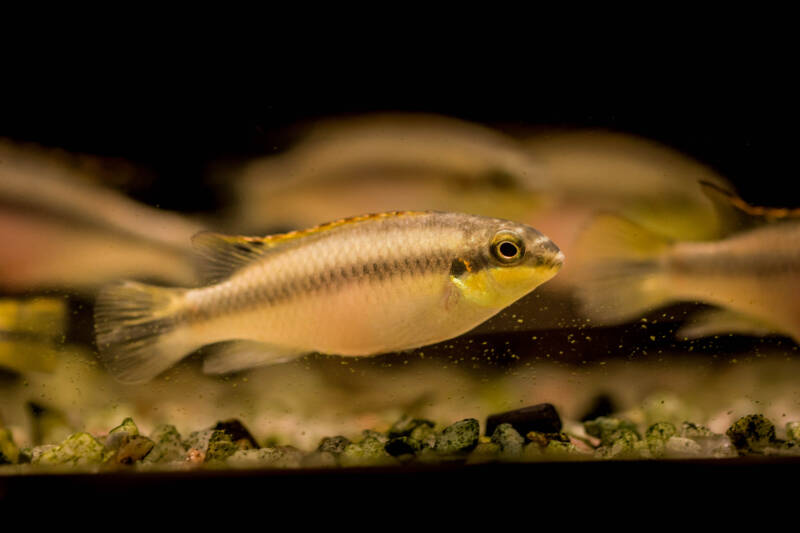
The kribensis cichlid (Pelvicachromis pulcher) is known by several common names. You may see it referred to as the rainbow cichlid or rainbow krib.
This fish has a tall, elongated body shape that is laterally compressed.
Coloration
Their base color is silver-grey or white, and a large black stripe runs the length of the body from the tip of the nose to the end of the tail. Many feature a second black stripe along the top of the body.
The dorsal and tail fins have fiery red tints on the edges. Stripes of bright blue highlight the pectoral and anal fins.
How can you tell if a kribensis is male or female?
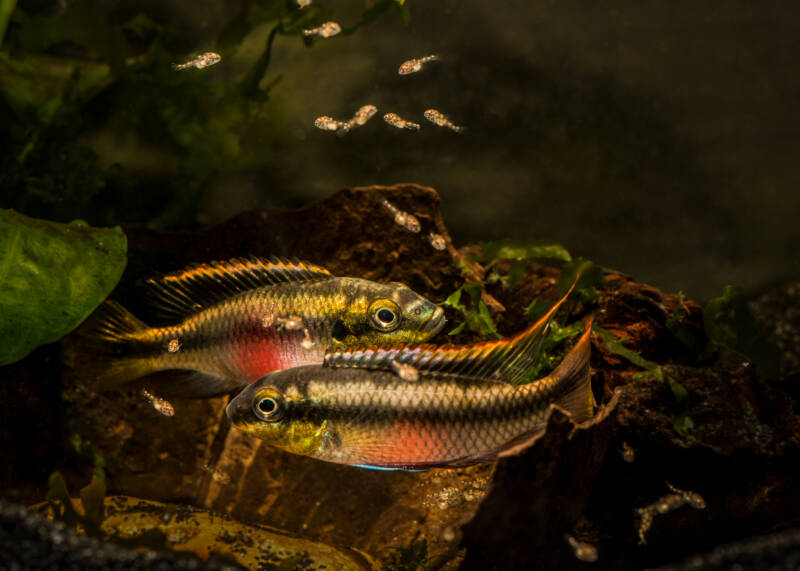
This is one species with a good amount of gender differentiation.
The females are easily spotted by the presence of a bright red spot on their belly, which becomes brightly colored when they are ready to breed.

Males, on the other hand, have visibly pointed dorsal fins and anal fins. These both sweep backward over the tail and end in a point.
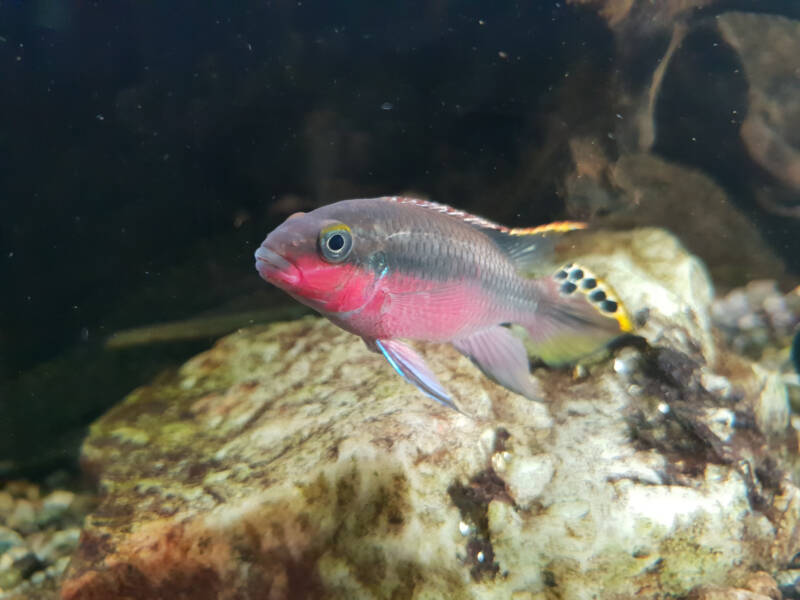
Size
The kribensis cichlid reaches an adult length between 3 to 4 inches (7.6 to 10 cm), with males tending to be longer than the females. This species is considered a dwarf cichlid.
Lifespan
The upper end of the kribensis’ lifespan is five years in captivity.
The ability of your cichlid to reach this age depends greatly on the care you provide. Good water quality, a well-balanced diet, and a peaceful tank setting are essential to your cichlid’s long life.
Behavior
Here is where things get a bit more complicated, depending on the situation.
People often ask: are kribensis cichlids aggressive? In the right environment, this is a peaceful species that can get along with other fish in a community tank.
The biggest behavioral issue with the kribensis is territorial guarding, which can be pronounced during breeding times.
These fish will stake a claim on a cave and vigorously defend it. If there is enough room in the tank and ample hiding spaces, this should not be much of an issue.
In addition, your kribensis may nip the fins of slow-swimming fish.
This species is very active and will dig frequently in the sandy substrate. While they do not typically damage plants, they can uproot them.
The kribensis is a strong swimmer as well and can jump out of a tank that does not have a well-fitting cover.
How many per gallon?
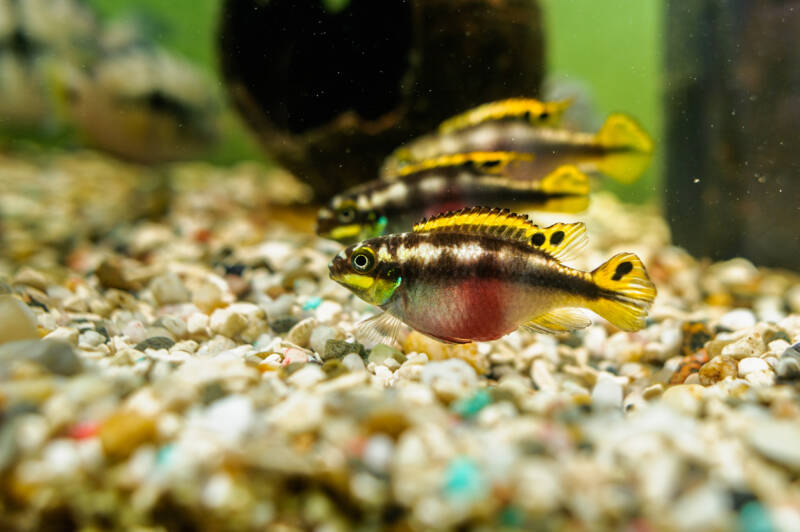
You can keep two kribensis cichlids in a minimum tank size of 20 gallons, but if you can manage a larger one, in the range of 30 to 50 gallons, your fish will enjoy it even more.
The additional room gives your fish ample swimming space, a chance to set up a territory, and may contribute to a peaceful coexistence.
Can you keep a single kribensis?
Yes, but they may not display their best colors or their most active behaviors when on their own.
Tank Setup
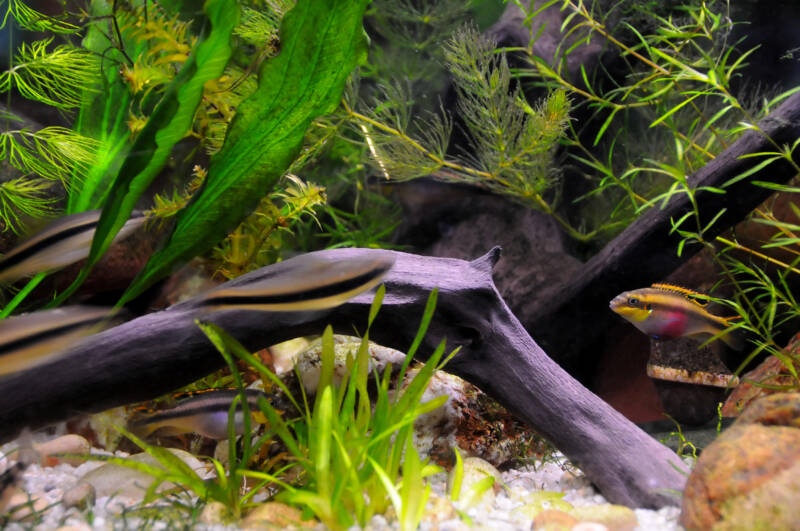
There are a few simple guidelines for setting up a tank for your kribensis.
Decorations
Line the bottom of your tank with dark-colored sand or fine gravel substrate. Next, add plenty of live plants.
Do kribensis eat plants? No, but they do love to dig and can uproot any plants that are not well secured.
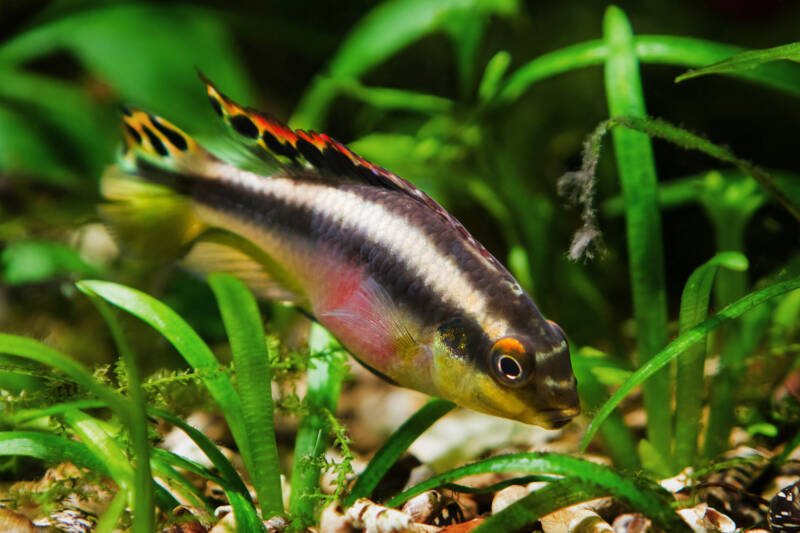
Select plants that can tolerate low light conditions, such as java moss or fern, hornwort, or anubias.
Finally, create some hiding spaces. These can be smooth-sided caves, pots, rocks, or driftwood.
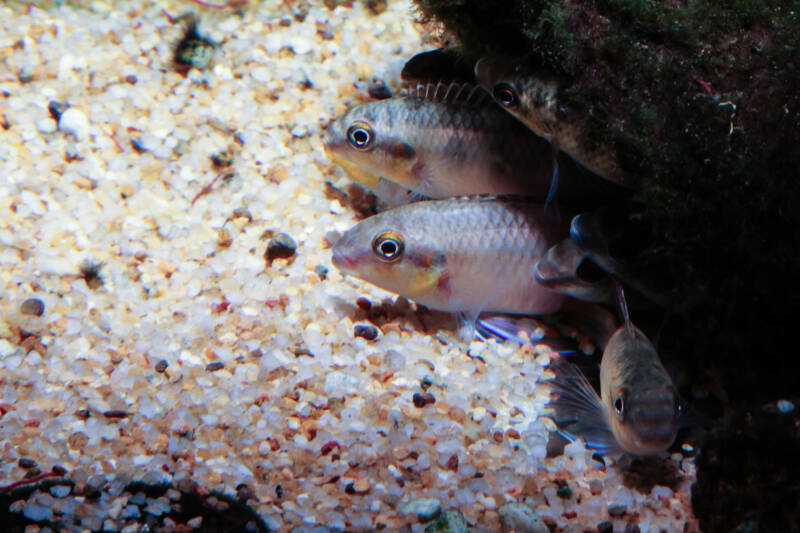
Place these objects near the outer edges of the tank or as far apart as possible to allow for the formation of territories.
Water Conditions
Just because the kribensis cichlid tolerates a wide range of water conditions, it does not mean you can be lax with the maintenance of your tank. Rapid shifts in water conditions can stress your fish and leave them susceptible to disease.
Ensure that the water temperature stays within the range of 75 to 79 degrees Fahrenheit (24 to 26 degrees C).
The pH level should trend toward neutral but can be anywhere in the range of 5.0 to 8.0. Keep the water hardness between 5 and 20 dGH.
Equipment
This species is sensitive to an increase in ammonia and nitrates, so install a robust filtration system.
A hang-on-back or a canister filter with the ability to turn over the water frequently should effectively remove contaminants but keep the current gentle. To monitor your water conditions, invest in some quality test kits.
This species does not like bright lighting, so install lower-powered lights.
A heater and thermometer will help ensure your water stays consistently in the kribensis cichlid’s optimum range.
Tank Mates
Can kribensis live in a community tank?
It depends. The kribensis cichlid can be a viable choice for a community tank with some caveats.
First, remember to keep your cichlid with other fish of similar size and temperament.
Second, these fish can be very territorial regarding their caves, especially when breeding. Males of the same species can become aggressive toward each other.
If you plan on keeping multiple kribensis in the same tank, evaluate their interactions to determine if they can coexist.
What fish can go with kribensis?
In addition to pairing your krib with another krib, consider keeping them with fish that occupy other places in the water column, such as the harlequin rasbora or pleco.
Make sure that there is plenty of space in your tank, there are multiple cave-like structures, and do not pair your kribensis with other cave-loving or long-finned species.
Consider the following to pair with your kribensis:
- Harlequin rasboras
- Barbs (cherry or tiger)
- Zebra Danios
- Gouramis
- Tetras (especially the Congo tetra)
- Plecos
- Catfish.
Avoid the following:
- Larger, more aggressive cichlids
- Crayfish and shrimp (the kribensis may eat them).
Will kribensis eat guppies/neon tetras?
Most likely, yes. The neon tetras and guppies are smaller than the full-grown kribensis and may pose a tempting target.
Can kribensis live with African cichlids?
Take caution when placing a kribensis in a tank with other African cichlids. Some species grow quite a bit larger than the kribs, and many can show aggression.
Food and Diet
What do kribs eat? These fish are omnivores that will readily eat a variety of foods.
The bulk of their diet should be sinking cichlid pellets. These fish spend a good amount of time near the bottom of the tank, so this type of food will reach them best.
Live or frozen protein-rich foods should also make up a portion of their diet. Your kribensis will enjoy bloodworms, daphnia, brine shrimp, or larvae.
Every now and then, give some cut-up zucchini or peas to satisfy their vegetable intake needs.
Never feed your fish any more than they can finish in 30 seconds to a minute. Leftover food will quickly decay and can impact your water quality. Feed them two or three times a day.
Breeding
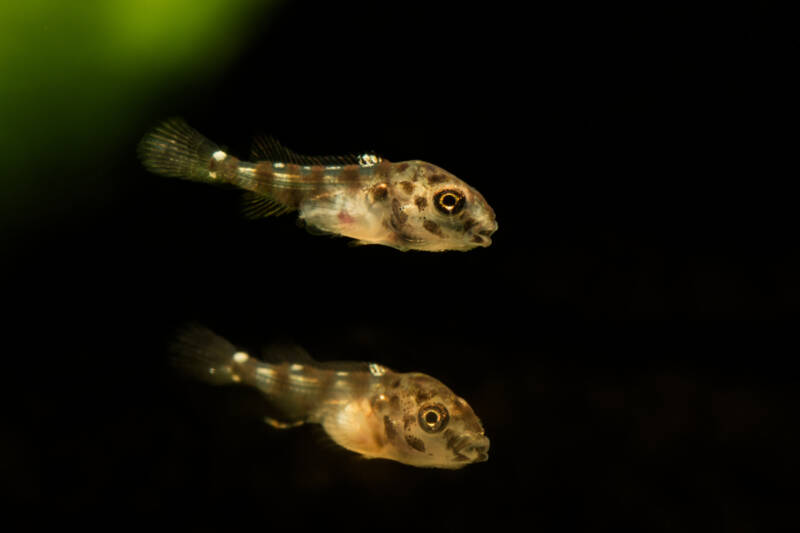
Couples will naturally pair off if you keep an equal number of male and female cichlids in your tank. These couples will establish territories and defend against others encroaching on their selected cave.
These protective instincts, and associated aggression, increase significantly during breeding times. Because of these behaviors, it is best to use a separate breeding tank.
Tank Setup
Set up your breeding tank as you did the community tank, with a fine gravel substrate and cave feature.
Set the water temperature between 77- and 80-degrees Fahrenheit (25 to 27 degrees C) and the pH to 7.0.
Higher pH levels can result in more male offspring, while lower levels can mean more females.
Install a sponge filter, which will help maintain water quality while not posing a danger to the fry.
Condition Your Breeding Pair
Feed your breeding pair high protein, live foods for one to two weeks to condition them for breeding. Some excellent choices are bloodworms and daphnia.
When the female is ready to spawn, her belly will turn bright red.
Spawning Behaviors
The female kribensis will then display courting behaviors for the male. Both fish will prepare their cave by cleaning it out.
After that, the female will lay between 40 to 300 eggs and the male will fertilize them. She will stay in the cave to guard the eggs while the male guards the territory.
Caring for the Fry

The eggs should hatch within five to seven days. At first, the newborn fry will feed off their egg sacs.
After about five days, the fry will become free-swimming. At this point, you can feed them liquid fry food or infusoria.
They will quickly transition to eating baby brine shrimp, which you can feed them for one to two weeks before introducing ground-up flake foods.
The fry grow quickly at first, reaching a length of 0.5 inches (1 cm) in two to four weeks.
They will begin to show their bright colors when they have reached 1 inch (2.5 cm) in length.
Do kribensis eat their fry?
No. The parents will watch over the baby fish as they develop, but once the fry are eating and growing well, you can remove the parents and place them back in the community tank.
In fact, after four weeks, the parents will be ready to breed again and may show aggression toward the juveniles.
Hardiness and Diseases
Overall, these fish are hardy and adapt easily to their environment.
However, they can contract common freshwater fish diseases if you do not keep up with tank maintenance and water quality monitoring.
The ailments to watch for are ich, fin rot, and dropsy, all of which can be treated by isolating the infected fish, correcting any water quality issues, and treating your fish with medication.
Still, it is better to avoid these infections in the first place for your fish to have a long, healthy life.
Closing Thoughts
The kribensis cichlid is an attractive choice for reasons beyond its beautiful looks.
Easy to care for and active, this fish is also quick to breed in an aquarium setting and exhibits unique parenting behaviors.
Its semi-aggressive nature makes it not necessarily the best choice for someone completely new to fish keeping.
However, for those with some experience, the kribensis is an excellent “first cichlid.” With proper care and selection of tank mates, it can make a fun addition to a community tank.
Do you keep your kribensis in a species-only or a community tank?
What are some of your favorite species with which to pair them?
We would love to hear from you!
